

Video Courses on PHP, JavaScript, and more. The PHP Practitioner. "This Is How We Built It" Case Studies. Unlike many other industries, the web design community is all about sharing knowledge and experience.
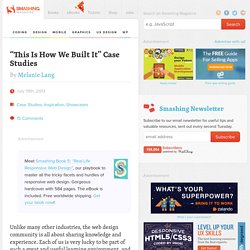
Each of us is very lucky to be part of such a great and useful learning environment, and it is up to us to embrace it — to embrace our learning experiences, and also to embrace our ability to share. Not only are case studies a great way to explain the design process of an agency, but they also help designers and developers to learn from each other. Seeing how designers work, create, build and play is great, and furthermore, you can learn how to write a great case study yourself and how to use one to spice up your portfolio1. In today’s overview of useful case studies, we’ve featured studies that have recounted decisions made about particular design elements, as well as studies of full overhauls and their accompanying technical challenges.
Most of them provide interesting insights into failures and successes, stories, workflows and design decisions made and rejected. Stream Updates with Server-Sent Events - HTML5 Rocks. Introduction I wouldn't be surprised if you've stumbled on this article wondering, "What the heck are Server-Sent Events (SSEs)?
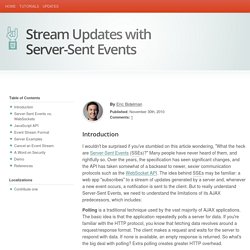
" Many people have never heard of them, and rightfully so. Over the years, the specification has seen significant changes, and the API has taken somewhat of a backseat to newer, sexier communication protocols such as the WebSocket API. The idea behind SSEs may be familiar: a web app "subscribes" to a stream of updates generated by a server and, whenever a new event occurs, a notification is sent to the client. But to really understand Server-Sent Events, we need to understand the limitations of its AJAX predecessors, which includes: Polling is a traditional technique used by the vast majority of AJAX applications. Using server-sent events - Web APIs. Developing a web application that uses server-sent events is quite easy.
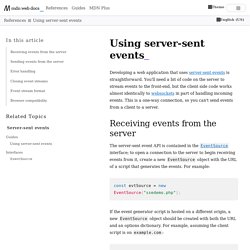
You'll need a bit of code on the server to stream the events to the web application, but the web application side of things works nearly identical to handling any other type of event. Receiving events from the serverEdit The server-sent event API is contained in the EventSource interface; to open a connection to the server to begin receiving events from it, create a new EventSource object specifying the URI of a script that generates the events. For example: var evtSource = new EventSource("ssedemo.php"); If the event generator script is hosted on a different domain a new EventSource object should be created that specifies both the URI and options dictionary.
Once you've instantiated your event source, you can begin listening for messages: This code listens for incoming messages (that is, notices from the server that do not have an event field on them) and appends the message text to a list in the document's HTML. Getting Started with WebRTC - HTML5 Rocks. WebRTC is a new front in the long war for an open and unencumbered web.
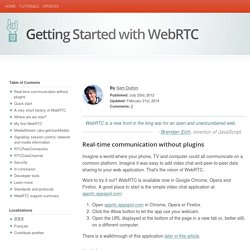
Brendan Eich, inventor of JavaScript. An Introduction To Node.js And MongoDB. Node.js is a rapidly growing technology that has been overtaking the world of server-side programming with surprising speed.

MongoDB is a technology that’s revolutionizing database usage. Together, the two tools are a potent combination, thanks to the fact that they both employ JavaScript and JSON. Isotope · Layout modes. Isotope can position items with different layout modes.
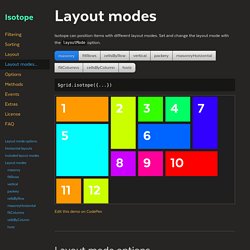
Set and change the layout mode with the layoutMode option. The Absolute Beginner's Guide to Node.js. There's no shortage of Node.js tutorials out there, but most of them cover specific use cases or topics that only apply when you've already got Node up and running.
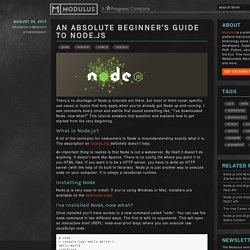
I see comments every once and awhile that sound something like, "I've downloaded Node, now what? " "Official" way to author a jQuery Plugin, and maintain chainability. AngularJS Articles, Workshops & Developers ready to help. A top resource! Native_javascript_data_binding. Two-way data-binding is such an important feature - align your JS models with your HTML view at all times, to reduce boilerplate coding and enhance UX.
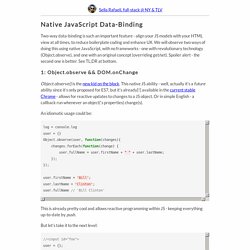
We will observe two ways of doing this using native JavaScript, with no frameworks - one with revolutionary technology (Object.observe), and one with an original concept (overriding get/set). Spoiler alert - the second one is better. See TL;DR at bottom. 1: Object.observe && DOM.onChange. BasicContext: Easy menus for your website. React.js Introduction For People Who Know Just Enough jQuery To Get By · React for Designers. Updates: Jul 15, 2016: Updated for React 15.
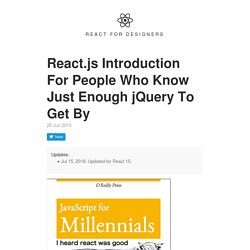
I also heard React.js was good and recently spent some time playing with it. Now that I’m pretty comfortable with React, I decided to write a tutorial on this subject. Target Audience: People Who Know Just Enough jQuery to Get by Before I begin, I’d like to clarify who my target audience is. Zed Shaw, the author of “Learn Code the Hard Way” series, recently wrote an excellent blog post called Early v.s. Baffle.js. PHP: The Right Way. There’s a lot of outdated information on the Web that leads new PHP users astray, propagating bad practices and insecure code.

PHP: The Right Way is an easy-to-read, quick reference for PHP popular coding standards, links to authoritative tutorials around the Web and what the contributors consider to be best practices at the present time. There is no canonical way to use PHP. This website aims to introduce new PHP developers to some topics which they may not discover until it is too late, and aims to give seasoned pros some fresh ideas on those topics they’ve been doing for years without ever reconsidering. This website will also not tell you which tools to use, but instead offer suggestions for multiple options, when possible explaining the differences in approach and use-case.